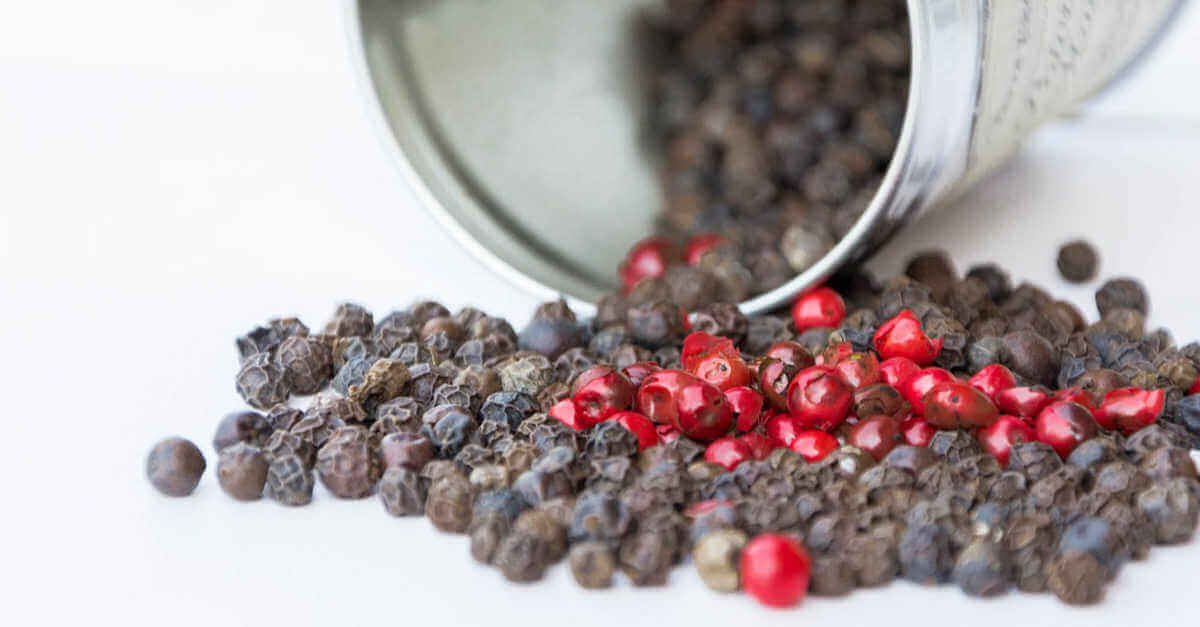Autumn is the perfect time to enjoy spicy, stimulating oils — like our November Oil of the Month selection, Pink Berries CO2! This fresh and spicy extract has a unique aroma that is popular throughout the perfumery business as a wonderful alternative to Black Pepper. The exotic scent carries hints of juniper and blends beautifully with a wide array of fruity, woody, and floral blends.
Let’s give this amazing CO2 its time in the spotlight and learn a little more about where these berries come from, how the extraction process works, and some of the best ways to bring the benefits of Pink Berries CO2 into your life!
Background
“Pink Berries” is an extract with many different names, including pink pepper, false pepper, Christmasberry, and Florida Holly . It comes from the Brazilian Pepper tree (Schinus terebinthifolius), which is a small, often multi-trunked evergreen tree or large shrub with glossy green leaves, small white summer flowers, and showy bright pink berries that ripen in the winter. These bright and leafy fruit-laden sprigs are often used as Christmas decorations in areas where the tree flourishes .
The Brazilian Pepper tree is native to Argentina, Paraguay, and Brazil, but has been introduced in tropical to sub-tropical areas around the world, like Florida and Hawaii, where it has naturalized and in many cases become invasive . The tree is known to spread rapidly, especially in environments like roadsides, fields, and pastures . The berries are harvested and sometimes sold as “pink peppercorns” but it should be noted that they are unrelated to true pepper and can actually cause allergic reactions if consumed by people .
How it’s made
Pink Berries CO2 undergoes an extraction process that is much different from steam distillation (a common process for obtaining essential oils). With CO2 extracts, carbon dioxide undergoes pressure until it’s a liquid. Then, this solvent removes the oil from the plant material. With this solvent, there is no residue left behind, and the precious oil is removed using much lower temperatures, meaning fewer properties within the oils are sacrificed .
 Benefits
Benefits
While Pink Berries CO2 is highly valued in perfumery due to its exotic scent, it offers several wonderful mind and body benefits. Diffuse or inhale the aroma to enjoy its uplifting and stimulating qualities. It’s wonderful for a personal aromatherapy inhaler (use about 15 drops). Use topically to help calm occasional digestive upset or to ease the discomfort associated with sore muscles due to overexertion. Use it in first aid preparations for minor scrapes and sores. Just make sure to dilute it to 1-2% in your favorite carrier oil, lotion, or cream.
Some things you need to know about Pink Berries CO2…

Is it KidSafe? Yes!
Shelf Life: 1-2 years
Cautions: Do not use undiluted on skin. Keep out of reach of children. If pregnant or under a doctor’s care, consult your physician. Recommended for external use only.
Blending
Digestive Comfort
What you’ll need:
- 3 drops of Pink Berries CO2
- 1 teaspoon of your favorite carrier oil
To use, blend Pink Berries CO2 with the carrier and massage onto the abdomen for occasional stomach upset.
Mental Boost Diffuser Blend
What you’ll need:
- 3 drops of Pink Berries CO2
- 3 drops of Bergamot
Add all these products to your cart
To use, add drops to your aromatherapy diffuser whenever you could use a brain boost!
Spicy and Festive Diffuser Blend
What you’ll need:
- 4 drops of Pink Berries CO2
- 3 drops of Juniper Berry
- 1 drop of Rose Absolute
Add all these products to your cart
To use, add drops to your aromatherapy diffuser for a fun, unique, and spicy aroma.

Post Workout Support

What you’ll need:
- 7 drops Bergamot
- 6 drops Pink Berries CO2
- 5 drops Spruce Black
- 1 tablespoon of Jojoba Carrier Oil or carrier of your choice
Add all these products to your cart
To use, blend the drops of essential oils with the Jojoba and massage onto the areas of concern.
Sources:
Schinus terebinthifolius. (n.d.). Retrieved from https://www.cal-ipc.org/plants/profile/schinus-terebinthifolius-profile/
Schinus terebinthifolius. (n.d.). Retrieved from https://www.missouribotanicalgarden.org/PlantFinder/PlantFinderDetails.aspx?taxonid=275940&isprofile=0&
Cuda, J. P.; Ferriter, A. P.; Manrique, V.; Medal, J. C. (2011). Interagency Brazilian Peppertree (Schinus terebinthifolius) Management Plan for Florida–2nd edition,
Bowles, J. (2014). The Chemistry of Aromatherapeutic Oils. Allen & Unwin. 2014. Print.









